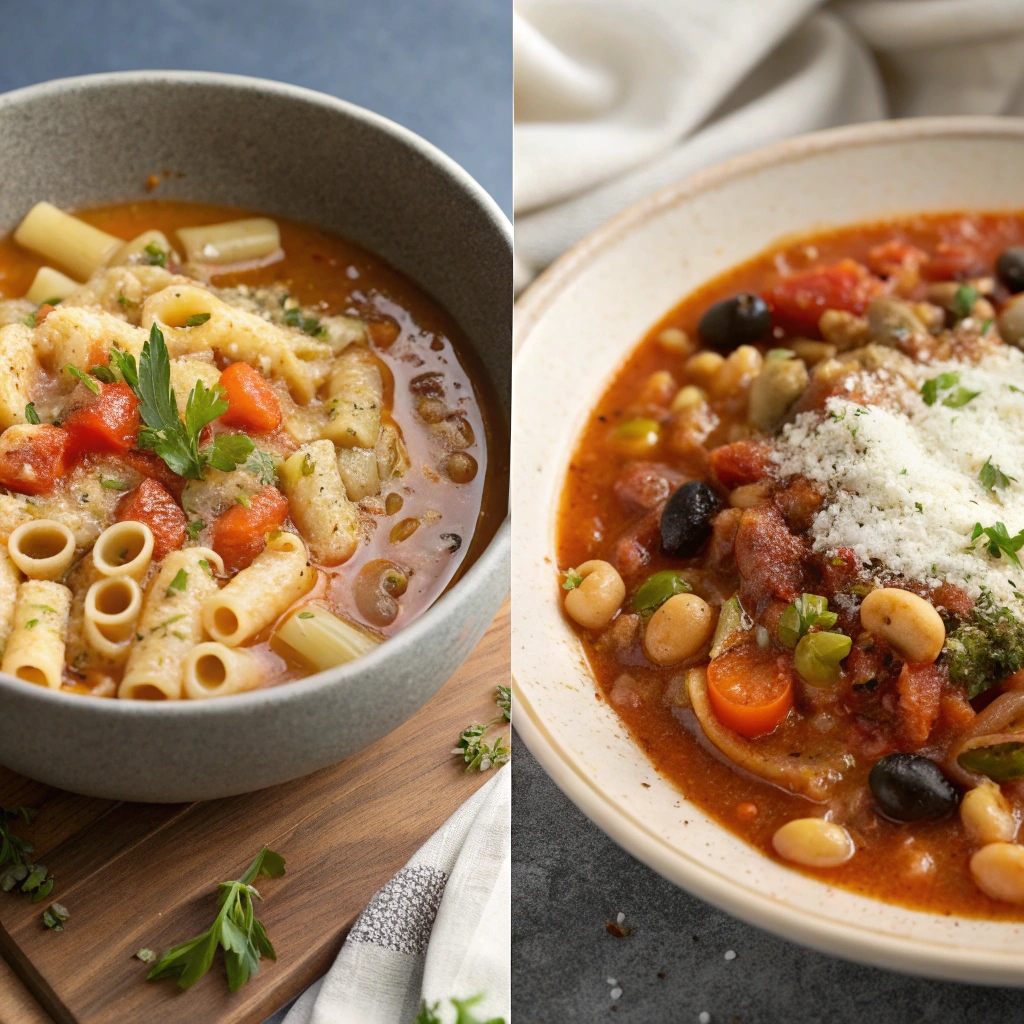Have you ever heard someone mention “fazool” and wondered, “Wait, isn’t that fagioli? Or is it something else entirely?” 🤔 You’re not alone! These two terms, while closely related, often confuse people—especially if you’re a foodie or a fan of Italian-American culture. So, what’s the real difference between fazool and fagioli? Let’s break it down in a way that’s simple, fun, and oh-so-satisfying.
First things first—fazool and fagioli are both words related to beans. Yes, beans! Specifically, “fagioli” (pronounced fa-JOH-lee) is the Italian word for beans. Fazool, on the other hand, is what happens when the word “fagioli” takes a little trip across the Atlantic and lands in Italian-American slang.
Table of contents
Origin and Meaning of Fazool
The term “fazool” is actually a playful adaptation of “fagioli.” Italian immigrants who settled in the United States brought their recipes and their words with them, but over time, many Italian words took on new pronunciations or spellings. Fazool comes from the Neapolitan dialect, where fagioli sounded more like fazool when spoken quickly.
Fun Fact:
Ever heard the Dean Martin song, “That’s Amore”? 🎵 He sings, “When the stars make you drool, just like pasta fazool, that’s amore!” Yep, he’s singing about pasta fazool—a delicious bean-and-pasta soup.
The Italian Roots of Fagioli
Fagioli is as Italian as it gets. The word itself traces back to the Latin term phaseolus, which means “bean.” Italians love their beans, and it shows in the countless recipes where fagioli are the star. From minestrone to pasta e fagioli, beans are a staple in Italian kitchens.
Beans weren’t just a food for peasants; they were a vital source of protein and an affordable ingredient that could stretch a meal to feed an entire family. That’s why fagioli has remained such a beloved part of Italian cuisine for centuries.

Cultural Context of Fazool and Fagioli
Fazool in American Culture
When Italian immigrants settled in places like New York and New Jersey, they brought their traditions along. But as they learned English, their language evolved. Fazool became a term that was easier to pronounce for English speakers, and it stuck.
Fazool isn’t just a word; it’s a little piece of Italian-American culture. It’s nostalgia in a bowl, a reminder of Sunday dinners with the family, and a tribute to the resilience of immigrants who made a new life in a foreign land.
Fagioli in Italian Tradition
Back in Italy, fagioli isn’t just a word for beans—it’s a way of life. Whether it’s creamy cannellini beans in Tuscany or hearty borlotti beans in northern Italy, every region has its own way of celebrating fagioli. Italians take pride in their recipes, passing them down through generations like heirlooms.
Linguistic Variations: Why the Confusion?
Fazool: A Dialectical Twist
Italian isn’t one language; it’s a collection of dialects. What you call “fagioli” in standard Italian might be “fasuli” in Neapolitan or “fasò” in Venetian. Dialects add flavor (pun intended!) to the language, and fazool is just one of many variations that came out of this linguistic melting pot.
Fagioli: Regional Pronunciations in Italy
Even within Italy, the pronunciation of “fagioli” can vary. In southern Italy, it might sound closer to fazool, while northern Italians might emphasize the “gi” sound more. It’s like how Americans say “tomato” and Brits say “tom-ah-to.” Same thing, slightly different vibe!
Blockquote Example:
“Fazool and fagioli are two sides of the same bean—one steeped in Italian tradition, the other born out of cultural adaptation. Together, they tell a story of migration, evolution, and delicious meals shared around the table.”
Culinary Differences and Misconceptions
Culinary Differences: Are Fazool and Fagioli the Same?
Now here’s the question that keeps food lovers scratching their heads: Are fazool and fagioli the same thing? Technically, yes—both refer to beans. But the difference lies in how they’re used in recipes, as well as their cultural connotations. Let’s unpack this delicious mystery.
Fazool: The Heart of Pasta Fazool
When Italian-Americans say “fazool,” they’re often talking about pasta fazool, a hearty, comforting dish made of pasta and beans. The full Italian name is pasta e fagioli (pasta and beans), but in the States, the name got shortened to fazool.
Pasta fazool isn’t just food—it’s a vibe. It’s that warm bowl of goodness you crave on a chilly day, made with simple, affordable ingredients like:
- Beans (usually cannellini or borlotti)
- Small pasta shapes (like ditalini or elbow macaroni)
- Tomato sauce (light or rich, depending on preference)
- Herbs and garlic (because no Italian recipe skips these!)
Here’s a quick recipe breakdown for pasta fazool:
| Ingredient | Quantity |
|---|---|
| Cannellini beans | 1 cup (cooked) |
| Ditalini pasta | 1 cup |
| Crushed tomatoes | 1 can (14 oz) |
| Garlic cloves | 3 (minced) |
| Olive oil | 2 tbsp |
| Fresh basil (optional) | A few leaves |
Fagioli: A Star in Traditional Italian Cuisine
In Italy, fagioli is less about a specific dish and more about celebrating beans in all their forms. While pasta fazool is an Italian-American classic, Italian cooks have a broader repertoire for fagioli, like:
- Minestrone Soup: A chunky vegetable soup with beans.
- Fagioli All’Uccelletto: A Tuscan dish of beans cooked with sage and tomatoes.
- Bean Salads: Light, refreshing, and perfect for summer.
Fagioli dishes are often regional. Northern Italy might use creamy borlotti beans, while southern Italy leans toward cannellini or chickpeas. Each recipe reflects the unique flavors of its region.

Common Misconceptions About Fazool and Fagioli
Are Fazool and Fagioli Two Different Ingredients?
This is one of the most common myths out there. To set the record straight: fazool and fagioli are not two separate ingredients. They’re the same thing—beans! The difference lies in the name, influenced by dialects and culture.
Think of it like soda vs. pop. They’re both carbonated drinks, but what you call them depends on where you’re from. Fazool and fagioli follow the same logic!
How Pop Culture Contributed to the Confusion
You can’t talk about fazool without mentioning its pop-culture fame. Songs like Dean Martin’s “That’s Amore” and TV shows featuring Italian-American families have immortalized fazool as a household word. While this has made fazool famous, it’s also muddied the waters about its connection to fagioli.
Here’s where things get tricky: Fazool became so iconic in America that many people don’t even realize it’s just a slang version of fagioli.
Nutritional Comparison: Fazool vs. Fagioli
| Nutrient | Fazool (Cannellini Beans) | Fagioli (Borlotti Beans) |
|---|---|---|
| Calories (per cup) | 225 | 200 |
| Protein | 15g | 14g |
| Fiber | 11g | 12g |
| Iron | 20% DV | 15% DV |
| Folate | 50% DV | 60% DV |
Beans are a nutritional powerhouse no matter what you call them. They’re loaded with protein, fiber, and essential vitamins, making them a must-have in any healthy diet.

Tips for Cooking with Fazool and Fagioli
Choosing the Right Beans for Your Dish
Picking the right bean depends on the recipe. Cannellini beans are creamy and mild, perfect for soups and stews. Borlotti beans, on the other hand, have a slightly nutty flavor that works well in salads or with rustic bread.
Simple Recipes to Try
- Quick Pasta Fazool
- Sauté garlic in olive oil, add crushed tomatoes, beans, and cooked pasta. Simmer and serve with grated Parmesan. 🍝
- Tuscan Bean Salad
- Mix cooked borlotti beans with olive oil, lemon juice, parsley, and red onions for a refreshing side dish.
Blockquote Example:
“Cooking with fazool or fagioli is like writing a love letter to your taste buds—simple, heartfelt, and utterly satisfying.”
Common Problems and Their Solutions When Using Fazool or Fagioli
Cooking beans sounds easy, right? Soak, boil, and eat. But let’s be real—anyone who’s ever worked with fazool or fagioli knows that things don’t always go as planned. From hard beans to bland dishes, problems happen. But don’t worry! Let’s tackle the most common issues and how to fix them.
Problem #1: Why Do Beans Sometimes Stay Hard After Cooking?
Ever boiled your beans for hours, only to end up with little pebbles instead of tender, creamy goodness? 😩 This is a super common issue.
Solution:
- Old Beans: Beans have a shelf life, and older beans take longer to cook—or might not soften at all. Always check the expiration date before buying.
- Soaking: If you’re not soaking your beans overnight, start now! Soaking reduces cooking time and helps beans cook evenly.
- Salt Timing: Don’t salt your beans too early! Salt hardens the skin, so add it midway through cooking or after they’ve softened.
Pro Tip: If you’re short on time, add a pinch of baking soda to the cooking water. It breaks down the beans’ skins, making them softer faster.
Problem #2: How to Avoid Bland Fazool or Fagioli Dishes
Beans are nutritional superheroes, but let’s face it—they’re not exactly flavor-packed on their own. A bland fazool or fagioli dish is like a story with no plot.
Solution:
- Season Generously: Beans soak up flavors like a sponge, so go big on garlic, onions, herbs (like rosemary or thyme), and spices.
- Use a Flavor Base: Start with sautéed garlic, onion, and olive oil before adding beans. This creates a rich, aromatic base.
- Don’t Forget the Broth: If your recipe calls for water, swap it out for vegetable or chicken broth for an instant flavor boost.
Fun Tip: Add a Parmesan rind to your soup or stew while cooking fazool or fagioli. It’ll melt slightly, infusing the dish with a salty, cheesy depth. 🧀
Problem #3: Beans That Fall Apart
While some recipes (like creamy soups) call for mushy beans, others need them to hold their shape. So, what’s the deal when they turn to mush?
Solution:
- Cook Gently: Use a simmer, not a boil. Rapid boiling can break the beans’ skins and cause them to fall apart.
- Watch the Time: Check your beans frequently as they cook. Overcooked beans are more likely to turn mushy.
- Acidic Ingredients: Adding tomatoes or vinegar too early can toughen beans and extend cooking time, so wait until they’re fully cooked before adding acidic ingredients.
Frequently Asked Questions About Fazool and Fagioli
1. What Is the Difference Between Pasta Fagioli and Pasta Fazool?
At their core, there’s no real difference between pasta fagioli and pasta fazool—they’re the same dish! The difference lies in the name. Pasta fagioli is the traditional Italian term, directly translating to “pasta and beans.” On the other hand, pasta fazool is the Italian-American adaptation of the name, stemming from the way “fagioli” is pronounced in certain Italian dialects. Think of fazool as the nickname that stuck when this beloved dish crossed the ocean to America.
2. What Does Fazool Mean in Italian?
Fazool doesn’t have a literal meaning in standard Italian—it’s actually derived from the word fagioli, which means “beans.” The term fazool reflects how Italian immigrants from southern regions like Naples and Sicily pronounced fagioli in their local dialects. Over time, fazool became a slang term among Italian-Americans for both beans and the iconic pasta dish, pasta fazool.
3. Why Is Pasta Fagioli Pronounced Pasta Fazool?
The pronunciation fazool comes from the Neapolitan and southern Italian dialects, where the word fagioli is often pronounced more like fazool. Italian dialects vary widely across regions, and many southern Italians brought their unique speech patterns to the United States. Over time, this regional pronunciation became the dominant way Italian-Americans referred to the dish, especially in areas like New York and New Jersey.
Fun Fact: The pronunciation fazool gained pop-culture fame thanks to Dean Martin’s classic song “That’s Amore,” where he crooned, “When the stars make you drool, just like pasta fazool…” 🎵
4. Why Do People Say Fazool?
People say fazool because it’s a product of cultural adaptation and linguistic evolution. When Italian immigrants settled in America, their language evolved to blend with English. Fazool became the more familiar, phonetically accessible term for fagioli, especially in Italian-American communities. It’s a reminder of the rich history and traditions that immigrants brought with them, adapting their language and recipes to fit their new lives while still staying true to their roots.
More Ideas: Exploring Related Topics
Here’s a professional “More Ideas” section that provides creative suggestions, internal links to related articles, and brief descriptions to enhance reader engagement and SEO performance.
1. Explore More About Pasta and Beans
- Irresistible Recipe for Pasta Fazool with Chicken
Dive into this comforting twist on pasta fazool featuring tender chicken and rich flavors. Perfect for hearty dinners or cozy weekends! 🍲 - Does Ranch Go Well with Pasta?
Curious about unique pasta pairings? Discover whether creamy ranch can elevate your favorite pasta dishes in unexpected ways. 🌱
2. Perfect Your One-Pan Pasta Dishes
- Chicken Meets Pasta: How to Nail One Pan
Learn the secrets to creating a delicious one-pan pasta dish that blends chicken, pasta, and veggies with minimal cleanup! 🍝 - Secrets to Making the Best Rotisserie Chicken Pasta
Love rotisserie chicken? Find out how to turn it into a mouthwatering pasta dish that’s quick, easy, and satisfying. 🍗
3. Tackle Cooking Challenges with Ease
- Why Are My Chicken Meatballs Spongy?
Struggling with the texture of your meatballs? Learn the common mistakes and how to fix them for perfect results every time. 🧆 - Quick Fixes for Dry Leftover Chicken
Transform dry leftovers into delicious meals with these simple tricks and recipes. No waste, just flavor! 👩🍳
4. Expand Your Culinary Skills
- Recipes with Similar Spices to Baingan Bharta
Love bold, smoky flavors? Discover other recipes that use spices similar to this iconic Indian dish. 🌶️ - How to Jazz Up Boring Pasta
Take your pasta dishes from ordinary to extraordinary with these creative and easy tips. 🥳
5. Find Inspiration for Quick Breakfasts
- Microwaving Frozen Breakfast Sandwiches
Learn how to achieve the perfect texture and flavor for frozen breakfast sandwiches in no time. 🍳 - Step-by-Step: How to Cook a Delicious Jimmy Dean Breakfast Sandwich
Follow this easy guide to cook your favorite breakfast sandwich to perfection. Great for busy mornings! 🌅
Conclusion: Understanding Fazool and Fagioli
After exploring the origins, culinary significance, and common questions about fazool and fagioli, it’s clear that these aren’t just simple words for beans—they’re symbols of culture, adaptation, and delicious meals. Whether you’re cooking pasta fagioli in an Italian village or serving pasta fazool at a Sunday dinner in Brooklyn, you’re taking part in a culinary tradition that spans continents.
Celebrating the Rich History of Beans in Culinary Traditions
Beans, humble as they may seem, have been staples of human diets for centuries. They’ve sustained civilizations, fed families through hard times, and brought people together around the table. In Italy, fagioli represent the heart of cucina povera, or “peasant cooking,” where simple, affordable ingredients are turned into something extraordinary.
Meanwhile, fazool captures the spirit of Italian-American resilience and creativity. Immigrants didn’t just bring their recipes—they adapted them to new environments and made them their own. Fazool is more than a word; it’s a piece of history served in every bowl.
Embracing the Diversity of Fazool and Fagioli in Global Cuisine
The beauty of fazool and fagioli lies in their versatility. Across the world, beans are a blank canvas for flavor:
- Italian Classics: From pasta fagioli to minestrone, beans are at the heart of many traditional dishes.
- Mediterranean Favorites: Chickpeas, lentils, and fava beans make appearances in hummus, stews, and salads.
- Latin American Staples: Black beans and pinto beans star in tacos, burritos, and soups.
- Asian Delights: Soybeans turn into tofu, miso, and edamame in East Asian cuisines.
No matter where you’re from, beans connect us all—they’re nutritious, sustainable, and endlessly adaptable.
Final Tips for Embracing Fazool and Fagioli
- Experiment with Recipes: Don’t stop at pasta fazool! Try other bean dishes like Tuscan bean stew or a refreshing borlotti bean salad.
- Use Fresh Herbs: Add rosemary, thyme, or parsley to your dishes to elevate the flavors.
- Don’t Skip the Parmesan Rind: Tossing in a Parmesan rind while your beans simmer adds incredible depth to the dish.
- Cook in Bulk: Make a big pot of beans and use them throughout the week in soups, salads, and stews.
- Honor the Tradition: When you cook fazool or fagioli, you’re keeping a rich culinary tradition alive.
Blockquote Example
“Fazool and fagioli aren’t just words—they’re stories of migration, resilience, and the universal language of comfort food.”
A Final Thought
So, whether you call it fazool or fagioli, one thing’s for sure: these beans are much more than a pantry staple. They’re a testament to the power of food to connect us to our roots while bringing us together in the present. And hey, next time you enjoy a steaming bowl of pasta fazool, you can impress your friends by explaining its fascinating history. 😉
Buon appetito! 🍝
Would you like to add anything else to the article, or is there another topic you’d like to explore? 😊
Print
What Is the Difference Between Fazool and Fagioli?
- Total Time: 45 minutes
Description
Pasta e Fagioli, affectionately known as “Pasta Fazool” in Italian-American communities, is a hearty Italian soup featuring tender pasta and creamy beans simmered in a savory tomato broth. This comforting dish, rooted in Italian peasant cuisine, has become a beloved staple, offering warmth and rich flavors in every spoonful.
Ingredients
- 2 tablespoons extra virgin olive oil
- 1 medium yellow onion, finely chopped
- 2 medium carrots, peeled and diced
- 2 celery stalks, diced
- 3 cloves garlic, minced
- 1 teaspoon dried Italian seasoning
- 1/4 teaspoon red pepper flakes (optional)
- 1 can (14.5 ounces) diced tomatoes, with juices
- 4 cups low-sodium chicken broth or vegetable broth
- 1 can (15 ounces) cannellini beans, drained and rinsed
- 1 can (15 ounces) red kidney beans, drained and rinsed
- 1 cup ditalini pasta or other small pasta shapes
- Salt and freshly ground black pepper, to taste
- 1/4 cup fresh parsley, chopped
- Freshly grated Parmesan cheese, for serving
Instructions
- Sauté Aromatics: In a large pot or Dutch oven, heat the olive oil over medium heat. Add the chopped onion, carrots, and celery. Sauté until the vegetables are tender, about 5-7 minutes.
- Add Garlic and Spices: Stir in the minced garlic, Italian seasoning, and red pepper flakes (if using). Cook for an additional 1 minute until fragrant.
- Incorporate Tomatoes: Pour in the diced tomatoes along with their juices. Stir to combine and let the mixture simmer for 5 minutes.
- Add Broth and Beans: Pour in the broth, then add the cannellini and kidney beans. Bring the soup to a boil, then reduce the heat to a simmer. Let it cook for 10 minutes to allow the flavors to meld.
- Cook Pasta: Add the ditalini pasta to the pot. Continue to simmer until the pasta is al dente, following the package instructions, typically 8-10 minutes. Stir occasionally to prevent sticking.
- Season and Serve: Taste the soup and adjust seasoning with salt and freshly ground black pepper as needed. Stir in the chopped fresh parsley. Ladle the soup into bowls and garnish with freshly grated Parmesan cheese. Serve hot with crusty bread.
Notes
- Variations: For a meatier version, consider adding diced pancetta or bacon during the sautéing of aromatics.
- Consistency: If you prefer a thicker soup, mash a portion of the beans before adding them to the pot.
- Storage: Store leftovers in an airtight container in the refrigerator for up to 3 days. The pasta may absorb some broth during storage; add a splash of broth or water when reheating to reach the desired consistency.
- Prep Time: 15 minutes
- Cook Time: 30 minutes
- Cuisine: Italian
Nutrition
- Serving Size: 6
- Calories: 320
- Sugar: 6g
- Sodium: 800mg
- Fat: 7g
- Saturated Fat: 1g
- Carbohydrates: 52g
- Protein: 13g
- Cholesterol: omg
Keywords: Pasta e Fagioli, Pasta Fazool, Italian Bean Soup, Comfort Food, Hearty Soup
